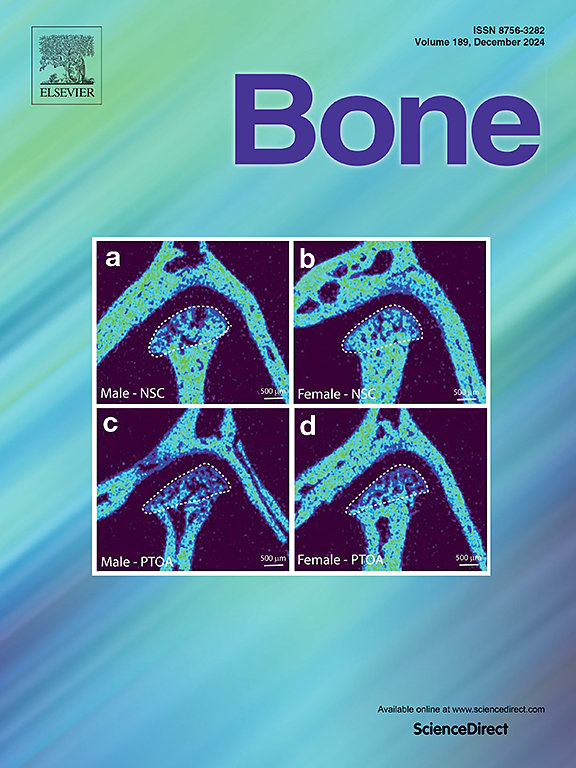转化生长因子β -2基因突变导致常染色体显性Camurati-Engelmann病2型(OMIM % 606631)
IF 3.5
2区 医学
Q2 ENDOCRINOLOGY & METABOLISM
引用次数: 0
摘要
camurti - engelmann病,1型(CED1, omim# 131300)是一种罕见的常染色体显性骨骼发育不良,由编码转化生长因子β 1 (TGFB1)的基因TGFB1内的选择性杂合功能丧失缺陷引起。在TGFB1前TGFB1的潜伏期相关肽(LAP)形成的1-4外显子中发现了CED1突变。因此,TGFB1的骨骼作用增强,从而促进骨形成,临床表现为“进行性骨干发育不良”。从24年前开始,TGFB1阴性分析表明CED罕见的遗传异质性,并在男性中指定了未知病因的在线孟德尔遗传“CED2”(OMIM % 606631)。在2024年,三例被认为是CED2的散发性病例被报道含有编码转化生长因子β 2 (TGFB2) LAP的TGFB2的两种突变中的一种。本文中,秘鲁一个家庭中具有CED2表型的三个成年人(父亲、儿子、女儿)发现了一种新的错义变异(c.108G >;T, p.R36S)在TGFB2 LAP结构域内。以整个长骨肥大为特征的衰弱性疼痛骨骼疾病,在男性中更严重,出现在童年早期。氨基二膦酸盐治疗似乎有帮助。他们的TGFB2变异在一个跨物种的高度保守结构域内,在gnomAD数据库中缺失,可能被polyphen2“破坏”,不被SIFT耐受,与TGFB1同源,在相同的氨基酸位置(R36)与一个报道的TGFB2突变,共分离为常染色体显性,并且根据ACMG指南“可能致病”。本文章由计算机程序翻译,如有差异,请以英文原文为准。
Transforming growth factor, beta-2 gene mutation causes autosomal dominant Camurati-Engelmann disease, type 2 (OMIM % 606631)
Camurati-Engelmann disease, type 1 (CED1, OMIM # 131300) is the rare autosomal dominant skeletal dysplasia caused by select heterozygous loss-of-function defects within the gene TGFB1, which encodes transforming growth factor beta 1 (TGFB1). CED1 mutations are found in TGFB1 exons 1–4 that form the latency-associated peptide (LAP) of pro-TGFB1. Consequently, skeletal action of TGFB1 increases and thereby enhances bone formation manifest clinically as “progressive diaphyseal dysplasia”. Beginning 24 years ago negative TGFB1 analysis suggested rare genetic heterogeneity for CED, and Online Mendelian Inheritance In Man designated, of unknown etiology, “CED2” (OMIM % 606631). In 2024, three sporadic occurrences considered CED2 were reported to harbor either of two mutations of TGFB2, which encodes the LAP of transforming growth factor beta 2 (TGFB2).
Herein, three adults (father, son, daughter) having the CED2 phenotype in a Peruvian family revealed a novel missense variant (c.108G > T, p.R36S) within the TGFB2 LAP domain. Debilitating painful skeletal disease featuring hyperostosis of entire long bones, worse in the men, presented early in childhood. Aminobisphosphonate therapy seemed helpful. Their TGFB2 variant was within a highly conserved domain across species, absent in the gnomAD database, “possibly damaging” by Polyphen-2, not tolerated by SIFT, homologous with TGFB1 at the same amino acid position (R36) as one reported TGFB2 mutation, co-segregated as autosomal dominant, and “likely pathogenic” per ACMG guidelines.
求助全文
通过发布文献求助,成功后即可免费获取论文全文。
去求助
来源期刊

Bone
医学-内分泌学与代谢
CiteScore
8.90
自引率
4.90%
发文量
264
审稿时长
30 days
期刊介绍:
BONE is an interdisciplinary forum for the rapid publication of original articles and reviews on basic, translational, and clinical aspects of bone and mineral metabolism. The Journal also encourages submissions related to interactions of bone with other organ systems, including cartilage, endocrine, muscle, fat, neural, vascular, gastrointestinal, hematopoietic, and immune systems. Particular attention is placed on the application of experimental studies to clinical practice.
 求助内容:
求助内容: 应助结果提醒方式:
应助结果提醒方式:


